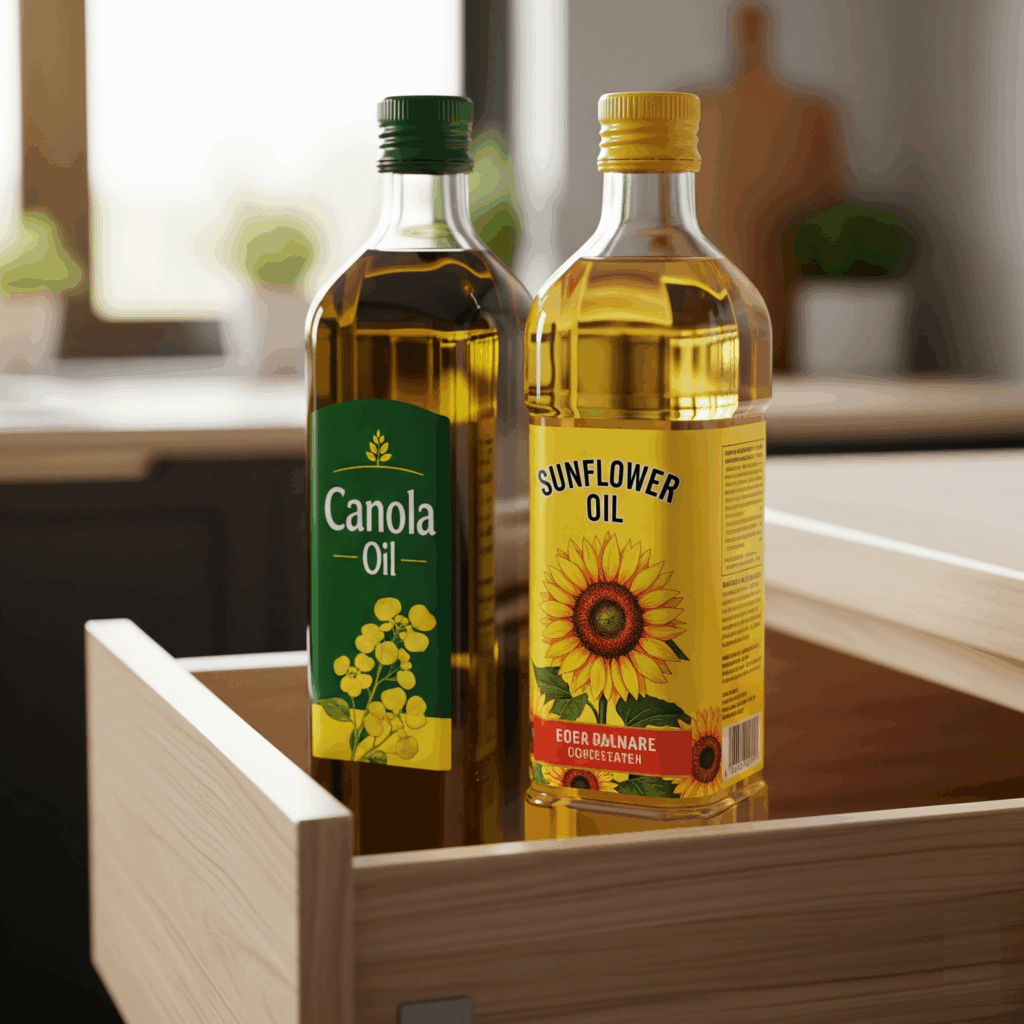By a Man Who Knows That What You Cook With Matters More Than You Think

Let me say this plainly:
You are not what you eat.
You are what you cook with.
Because the oil in your pan doesn’t just carry flavor — it becomes part of the food.
It soaks into your potatoes, your eggs, your mayonnaise.
And if that oil is a refined, deodorized, chemically extracted liquid labeled “heart-healthy,”
you’re not feeding yourself.
You’re conducting a long-term experiment — without consent, and without a control group.
So this isn’t a post about “fats are bad” or “vegetable oil is poison.”
This is a report from the kitchen, based on science, taste, and principle — for people who want to know what’s really going into their bodies.
Let’s talk about seed oils.
Not with fear.
With facts.
The Problem: Seed Oils Are Not “Vegetable Oils” — They’re Industrial Products
First, let’s kill a myth:
There is no such thing as a “vegetable oil.”
Vegetables don’t produce oil.
Seeds do.
And the oils we’ve been told are “healthy” for decades — canola, soybean, corn, sunflower, grapeseed, cottonseed — are not foods.
They are industrial seed oils: highly refined, bleached, deodorized, and extracted using solvents like hexane.
They are the product of mid-20th century agribusiness — not traditional cooking.
And they entered our kitchens not because they were better, but because they were cheaper.
Now, decades later, we’re seeing the cost.
Why Seed Oils Are Problematic (The Science)
- High in Omega-6 Fatty Acids
These are essential in small amounts — but most people now consume them in excess, leading to chronic inflammation, linked to heart disease, arthritis, and metabolic syndrome. - Unstable Under Heat
Seed oils oxidize easily when heated, creating harmful compounds like aldehydes — which are linked to cellular damage and long-term health risks. - Heavily Processed
They are not “natural.” They are factory-made: extracted with chemicals, stripped of flavor, then re-infused with artificial tocopherols (vitamin E) to prevent rancidity. - Promoted by Flawed Science
The “seed oils are heart-healthy” myth was built on outdated studies, industry funding, and the demonization of animal fats — none of which have held up under modern scrutiny.
In short:
You wouldn’t put motor oil in your truck and expect peak performance.
So why put industrial oil in your body?
The Taste Test: Science You Can Taste
I did a simple side-by-side test — no lab, no microscope. Just a pan, a nose, and a tongue.
Test 1: Frying Eggs
- Seed Oil (Canola):
Smelled faintly chemical. Eggs cooked with a greasy sheen. Taste: flat, slightly bitter aftertaste. - Avocado Oil:
Clean smell. Eggs browned evenly. Taste: rich, clean, no aftertaste.
Test 2: Roasting Potatoes
- Soybean Oil:
Potatoes browned unevenly. Surface felt slick. Taste: dull, with a lingering oiliness. - Lard (Leaf Fat, Rendered):
Crispy edges, fluffy inside. Smell: warm, nutty. Taste: deeply savory — like real food.
Test 3: Homemade Mayo
- Grapeseed Oil Mayo:
Bright yellow, runny. Flavor: sharp, almost metallic. - Ghee-Based Mayo:
Golden, thick. Flavor: rich, buttery, smooth — the way mayo should be.
Result:
Seed oils don’t enhance flavor.
They mask it.
And they leave a residue — on the plate, and possibly in the body.
The Alternatives: Real Fats for Real Cooking
You don’t need to go full off-grid.
You just need to replace the industrial with the intact.
Here are three proven, stable, delicious alternatives — each with a role in a rational kitchen.
1. Avocado Oil (The Modern Neutral)
- Smoke Point: ~480°F (250°C) — excellent for searing, roasting, frying.
- Flavor: Mild, buttery, clean.
- Best for: High-heat cooking, mayo, dressings.
- Tip: Buy refined (not extra virgin) for cooking; virgin for drizzling.
Advantage: Plant-based, stable, widely available — a bridge between old and new.
2. Lard (The Forgotten King)
- Smoke Point: ~370°F (190°C) — perfect for frying, sautéing, baking.
- Flavor: Rich, savory, enhances meat and potatoes.
- Best for: Tortillas, hash, roasting root vegetables.
- Myth: “Lard is unhealthy.”
Truth: Traditional lard (from pastured pigs) is mostly monounsaturated fat — like olive oil.
Advantage: Zero waste, traditional, deeply flavorful.
3. Ghee (Clarified Butter, Perfected)
- Smoke Point: ~485°F (252°C) — higher than butter, no milk solids.
- Flavor: Nutty, warm, luxurious.
- Best for: Eggs, sauces, mayo, sautéing greens.
- Bonus: Shelf-stable, lactose-free, and keeps for months.
Advantage: Combines the richness of butter with the stability of a high-heat oil.

The Principle: Cook With Integrity
This isn’t about dogma.
It’s about choice.
You can keep using seed oils.
They’re cheap. They’re everywhere.
But know what you’re accepting:
- A flavorless base
- A processed product
- An unknown long-term cost
Or, you can switch to fats that:
- Taste like food
- Come from whole sources
- Have been used for centuries
And yes — they cost more.
But so does health.
And so does dignity.
Final Thought: The Oil You Use Is a Statement
Every time you heat a pan, you make a decision:
Will this meal be built on industrial efficiency — or on real nourishment?
Seed oils are the food equivalent of plastic grass — green, uniform, and utterly fake.
The alternatives?
They’re the real thing.
Sometimes messy. Always honest.
So try one.
Start with ghee in your eggs.
Lard in your potatoes.
Avocado oil in your mayo.
And when you taste the difference — not in a lab, but on your tongue —
you’ll realize:
You weren’t eating less healthy food.
You were eating less food.
Now go cook something real.
And cook it with oil that deserves the heat.
